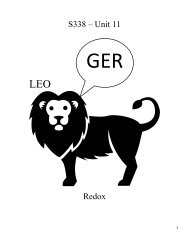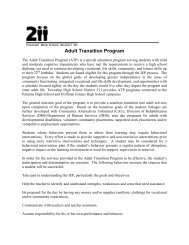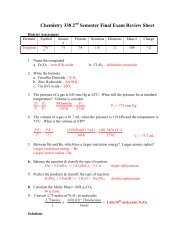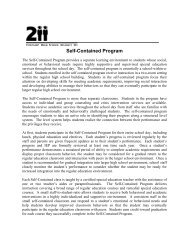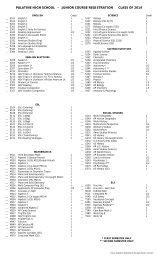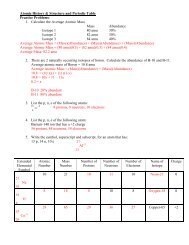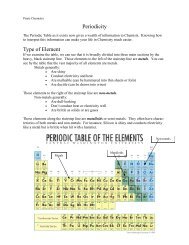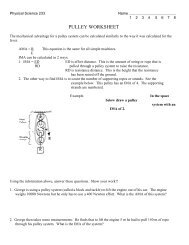AP Chemistry Unit 4- Homework Problems Chemical Equations and ...
AP Chemistry Unit 4- Homework Problems Chemical Equations and ...
AP Chemistry Unit 4- Homework Problems Chemical Equations and ...
You also want an ePaper? Increase the reach of your titles
YUMPU automatically turns print PDFs into web optimized ePapers that Google loves.
<strong>AP</strong> <strong>Chemistry</strong><br />
<strong>Unit</strong> 4- <strong>Homework</strong> <strong>Problems</strong><br />
<strong>Chemical</strong> <strong>Equations</strong> <strong>and</strong> Electrochemistry<br />
Types of Reactions & Balancing<br />
1. For each of the equations below, decide whether the reaction is an example of: synthesis,<br />
decomposition, single replacement, double replacement, or combustion<br />
a. CaI 2 + Br 2 CaBr 2 + I 2<br />
b. CH 4 + 2 O 2 CO 2 + 2 H 2 O<br />
c. 2 Al + 3 Cl 2 2 AlCl 3<br />
d. 6 K + N 2 2 K 3 N<br />
e. 3 MgCl 2 + 2 K 3 PO 4 Mg 3 (PO 4 ) 2 + 6 KCl<br />
f. CaCO 3 CaO + CO 2<br />
g. NH 4 OH NH 3 + H 2 O<br />
h. 2 Li + F 2 2 LiF<br />
i. CS 2 + 3 O 2 CO 2 + 2 SO 2<br />
j. Zn + Cu(NO 3 ) 2 Zn(NO 3 ) 2 + Cu<br />
2. Balance the following equations:<br />
a. Fe 2 O 3 + Mg MgO + Fe<br />
b. SF 4 + H 2 O SO 2 + HF<br />
c. BF 3 + H 2 O HF + H 3 BO 3<br />
d. C 6 H 5 CH 3 + O 2 H 2 O + CO 2<br />
e. Fe + H 2 O Fe 3 O 4 + H 2<br />
3. Predict the products <strong>and</strong> balance the equation:<br />
a. Si + Cl 2 <br />
b. Na 2 SO 4 + BaCl 2 <br />
c. CaO <br />
d. Zn + AgNO 3 <br />
e. C 8 H 18 + O 2
Stoichiometry<br />
1. For the reaction:<br />
4 Al + 3 O 2 2 Al 2 O 3<br />
a. How many moles of Al are needed to react with 9 moles of O 2 ?<br />
b. How many moles of Al 2 O 3 can be made from 3.2 moles of O 2 <strong>and</strong> excess Al?<br />
c. How many grams of O 2 are needed to react with 100 grams of Al?<br />
d. How many grams of Al 2 O 3 can be produced from 75 grams of Al <strong>and</strong> excess O 2 ?<br />
2. For the reaction:<br />
2 B 4 H 10 + 11 O 2 4 B 2 O 3 + 10 H 2 O<br />
a. How many moles of O 2 are needed to react with 3.7 moles of B 4 H 10 ?<br />
b. How many moles of B 2 O 3 can be made from 0.075 moles of O 2 <strong>and</strong> excess B 4 H 10 ?<br />
c. How many grams of B 4 H 10 are needed to react with 0.25 grams of O 2 ?<br />
d. How many grams of water will be made from 0.43 grams of B 4 H 10 <strong>and</strong> excess O 2 ?<br />
3. For the reaction:<br />
Na 2 SO 4 (s) + 4 C (s) Na 2 S (s) + 4 CO (g)<br />
a. If you mix 15 g of Na 2 SO 4 with 7.5 g of C, how many grams of Na 2 S can be made?<br />
b. If you mix 10 g of Na 2 SO 4 with 14.2 g of C, how many grams of CO can be made?<br />
4. For the reaction:<br />
2 Al + 3 Cl 2 2 AlCl 3<br />
a. If you mix 2.7 g Al <strong>and</strong> 4.05 g Cl 2 , which reactant is limiting?<br />
b. What mass of AlCl 3 can be made?<br />
c. What mass of the excess reactant remains?<br />
5. For the reaction:<br />
CaO + 2 NH 4 Cl 2 NH 3 + H 2 O + CaCl 2<br />
a. If 112 g of CaO <strong>and</strong> 224 g of NH 4 Cl are mixed, what is the theoretical yield of NH 3 ?<br />
b. If only 16.3 g of NH 3 is actually made, what is the % yield?
6. For the reaction:<br />
CuSO 4 + 4 NH 3 Cu(NH 3 ) 4 SO 4<br />
a. If you react 25 mL of 1.25 NH 3 with 7.5 grams of CuSO 4 , what is the theoretical yield of<br />
the product in grams?<br />
b. If you only get 0.63 grams of the product, what is the % yield?<br />
7. For the reaction:<br />
2 NaN 3 2 Na + 3 N 2<br />
What mass of NaN 3 is required to give 75 L of N 2 at a pressure of 1.3 atm <strong>and</strong> 25 o C?<br />
8. For the reaction:<br />
2 C 8 H 18 + 25 O 2 16 CO 2 + 18 H 2 O<br />
a. If 0.095 g of C 8 H 18 burns in O 2 , what will be the pressure of water vapor in a 4.75 L flask<br />
at 30 o C?<br />
b. If the O 2 gas needed for complete combustion was in the 4.75 L flask at 22 o C, what would<br />
its pressure have been?<br />
9. For the reaction:<br />
4 KO 2 + 2 CO 2 2 K 2 CO 3 + 3 O 2<br />
What mass of KO 2 is required to react with 8.90 L of CO 2 at 30 o C <strong>and</strong> 780 mm Hg?<br />
10. For the reaction:<br />
Na 2 CO 3 + 2 HCl 2 NaCl + CO 2 + H 2 O<br />
If 38.55 mL of HCl is needed to titrate 2.150 g of Na 2 CO 3 , what is the M of HCl?<br />
11. For the reaction:<br />
H 2 A + 2 NaOH Na 2 A + 2 H 2 O<br />
If 36.04 mL of 0.509 M NaOH is needed to reach the endpoint of 0.954 g of H 2 A, what is the<br />
molar mass of H 2 A?
Redox<br />
1. What are the oxidation numbers of the atom that is bolded in each of the following:<br />
a. Na<br />
b. Cl 2<br />
c. S 8<br />
d. Na +1<br />
e. Cl -1<br />
f. S -2<br />
g. BrO 3<br />
-1<br />
h. H 4 SiO 4<br />
i. HSO 4<br />
-1<br />
j. PF 6<br />
-1<br />
k. UO +2<br />
l. N 2 O 5<br />
m. C 2 O 4<br />
-2<br />
2. For each of the following reactions, identity the oxidizing agent <strong>and</strong> reducing agent:<br />
a. C 2 H 4 + 3 O 2 2 CO 2 + 2 H 2 O<br />
b. Si + 2 Cl 2 SiCl 4<br />
c. Cr 2 O 7 -2 + 3 Sn +2 + 14 H + 2 Cr +3 + 3 Sn +4 + 7 H 2 O<br />
d. FeS + 3 NO 3 -1 + 4 H + 3 NO + SO 4 -2 + Fe +3 + 2 H 2 O<br />
e. MnO 4 -1 + 5 Fe +2 + 8 H + Mn +2 + 5 Fe +3 + 4 H 2 O<br />
3. Balance the following reactions in a neutral solution:<br />
a. Fe +3 + I -1 Fe +2 + I 2<br />
b. Fe +2 + Cu +2 Cu + Fe +3<br />
c. Al + Sn +4 Sn +2 + Al +3<br />
4. Balance the following reactions in an acidic solution:<br />
a. MnO 4 -1 + HSO 3 -1 Mn +2 + SO 4<br />
-2<br />
b. CH 2 O + Ag +1 HCO 2 H + Ag<br />
c. Cr 2 O 7 -2 + Fe +2 Cr +3 + Fe +3<br />
d. CrO 4 -2 + HNO 2 Cr +2 + NO 3<br />
-1<br />
5. Balance the following reactions in a basic solution:<br />
a. CrO 4 -2 + SO 3 -2 Cr(OH) 3 + SO 4<br />
-2<br />
b. Zn + Cu(OH) 2 [Zn(OH) 4 ] -2 + Cu<br />
c. HS -1 + ClO 3 -1 S + Cl -1<br />
d. NiO 2 + Zn Ni(OH) 2 + Zn(OH) 2
<strong>Chemical</strong> Analysis<br />
1. A mixture of CuSO 4 <strong>and</strong> CuSO 4 *5H 2 O has a mass of 1.245 g. After heating to drive off the<br />
water, the mass is only 0.832 g. What was the mass % of CuSO 4 <strong>and</strong> CuSO 4 *5H 2 O in the<br />
original mixture?<br />
2. For the reaction:<br />
2 NaHCO 3 Na 2 CO 3 + CO 2 + H 2 O<br />
Heating a 1.7184 g sample of impure NaHCO 3 gives 0.196 g of CO 2 . What was the mass<br />
percent of NaHCO 3 in the original sample?<br />
3. For the reaction:<br />
BeC 2 O 4 *3 H 2 O (s) BeC 2 O 4 (s) + 3 H 2 O (g)<br />
a. If 3.21 g of BeC 2 O 4 *3H 2 O is heated, calculate:<br />
i) the mass of BeC 2 O 4 (s) formed<br />
ii) the volume of H 2 O (g) released at 220 o C <strong>and</strong> 735 mm Hg<br />
b. A 0.345 g of BeC 2 O 4 which contained an inert impurity was dissolved in enough water to<br />
give 100 mL of solution. A 20 mL portion of this was titrated with 0.0150 M KMnO 4 <strong>and</strong><br />
required 17.80 mL to reach the endpoint. The equation is as follows:<br />
16 H + + 2 MnO 4 -1 + 5 C 2 O 4 -2 2 Mn +2 + 10 CO 2 + 8 H 2 O<br />
i) Identify the reducing agent<br />
ii) Calculate the number of moles of each of the following at the endpoint of the titration:<br />
• MnO 4<br />
-1<br />
• C 2 O 4<br />
-2<br />
iii) Calculate the total moles of C 2 O 4 -2 that were in the 100 mL sample<br />
iv) Calculate the mass % of BeC 2 O 4 in the impure 0.345 g sample<br />
4. For the following reaction:<br />
Fe 2 O 3 (s) + 3 CO (g) 2 Fe (s) + 3 CO 2 (g)<br />
A 16.2 L sample of CO (g) at 1.5 atm <strong>and</strong> 200 o C is combined with 15.39 g of Fe 2 O 3<br />
a. How many moles of CO are present?<br />
b. What is the limiting reagent? Prove it with calculations.<br />
c. How many grams of Fe are made?<br />
d. How many L of CO 2 are made?
5. For the reaction:<br />
3 Ba(NO 3 ) 2 (aq) + 2 H 3 PO 4 (aq) Ba 3 (PO 4 ) 2 (s) + 6 HNO 3 (aq)<br />
If 200 mL of 3 M Ba(NO 3 ) 2 are mixed with 300 mL of 1 M H 3 PO 4 , calculate the following:<br />
a) The mass of Ba 3 (PO 4 ) 2 (s) formed<br />
b) The final concentration of the NO 3 -1 ion in solution<br />
6. For the reaction:<br />
MnO -1 4 + 5 Fe +2 + 8 H + Mn +2 + 5 Fe +3 + 4 H 2 O<br />
A 0.598 g sample of an iron-containing compound was analyzed. It required 22.25 mL of<br />
0.0123 M KMnO 4 to reach the equivalence point. What is the mass % of iron in the<br />
sample?<br />
Battery Basics<br />
1. What are two other terms to describe a battery?<br />
2. What are the three necessary parts of a battery?<br />
3. What charge is the cathode?<br />
4. What reaction takes place at the cathode?<br />
5. What charge is the anode?<br />
6. What reaction takes place at the anode?<br />
7. What purpose does the salt bridge serve?<br />
8. Write the following equations in shorth<strong>and</strong> notation:<br />
a. Cu +2 + Mg Mg +2 + Cu<br />
b. 2 Ag +1 + Sn Sn +2 + 2 Ag<br />
c. 2 Al + 3 Pb +2 3 Pb + 2 Al +3<br />
9. Write the two possible equations for the st<strong>and</strong>ard electrode:<br />
a.<br />
b.<br />
10. All ½ reactions are tabulated as what kind of reactions?<br />
11. What does it mean that voltage E o is an intensive property?<br />
12. Give the voltages for the following ½ reactions as written:<br />
a. Ca +2 + 2 e - Ca<br />
b. Br 2 + 2 e - 2 Br -1<br />
c. Na Na +1 + e -<br />
d. 2 I -1 I 2 + 2 e -<br />
13. Calculate the E o values for each of the following reactions as written. Which will be<br />
spontaneous?<br />
a. 2 Fe +3 + Cd Cd +2 + 2 Fe +2<br />
b. Zn +2 + Hg Hg +2 + Zn<br />
c. O 2 + 4 H +1 + 2 Ni 2 Ni +2 + 2 H 2 O<br />
d. 6 Br -1 + 2 Au +3 2 Au + 3 Br 2
14. In each of the reactions above in #13, which species is the cathode <strong>and</strong> which is the anode?<br />
a. Cathode = Anode =<br />
b. Cathode = Anode =<br />
c. Cathode = Anode =<br />
d. Cathode = Anode =<br />
15. A battery is made from using the following ½ reactions:<br />
Cu +2 + 2 e - Cu E o = +0.36 V<br />
V +2 + 2 e - V E o = -1.18 V<br />
Knowing that Cu +2 ions are blue <strong>and</strong> V +2 ions are purple, answer the following questions<br />
about a voltaic cell using Cu, Cu +2 , V, <strong>and</strong> V +2 ions.<br />
a. Write the equation that occurs at the cathode.<br />
b. Write the equation that occurs at the anode.<br />
c. Write the shorth<strong>and</strong> notation for the cell.<br />
d. What is the voltage under st<strong>and</strong>ard conditions.<br />
e. As the reaction progresses, what should happen to:<br />
i) The size of the copper electrode<br />
ii) The size of the vanadium electrode<br />
iii) The intensity of the blue color from the copper ion<br />
iv) The intensity of the purple color from the vanadium ion<br />
f. Which species is the oxidizing agent?<br />
g. Which species is the reducing agent?
Nernst Equation & Non-St<strong>and</strong>ard Conditions<br />
1. What are the conditions for the following that are considered to be st<strong>and</strong>ard?<br />
a. Concentration<br />
b. Pressure<br />
c. Temperature<br />
2. What is the equation for non-st<strong>and</strong>ard voltages?<br />
3. What is n?<br />
4. Write the equations for Q for each of the following reactions:<br />
a. Cu +2 + Mg Mg +2 + Cu<br />
b. 2 Ag +1 + Sn Sn +2 + 2 Ag<br />
c. 2 Al + 3 Pb +2 3 Pb + 2 Al +3<br />
5. What is n for each of the equations in problem #4?<br />
a.<br />
b.<br />
c.<br />
6. A battery is made from Ag, Ag +1 , Pb, <strong>and</strong> Pb +2 .<br />
a. What is the E o ?<br />
b. Write the balanced equation for the battery.<br />
c. What is the equation for Q?<br />
d. If the [Ag +1 ] is made to 0.25 M <strong>and</strong> the [Pb +2 ] is made to 2.5 M, what is the new<br />
voltage?<br />
e. What would the effect of having a large Pb electrode have on the voltage? Why?<br />
7. A battery is made from Cu, Cu +2 , Sn, Sn +2 .<br />
a. What is the E o ?<br />
b. Write the balanced equation for the battery.<br />
c. What is the equation for Q?<br />
d. If the [Cu +2 ] is made to 1.75 M <strong>and</strong> the [Sn +2 ] is made to 0.025 M, what is the new<br />
voltage?<br />
e. What would the effect of having a large Cu electrode have on the voltage? Why?<br />
8. A battery is made from Zn, Zn +2 , Fe, Fe +2 . Describe what effect each of the following will<br />
have on the st<strong>and</strong>ard voltage of the battery.<br />
a. Increasing [Zn +2 ]<br />
b. Decreasing [Fe +2 ]<br />
c. Increasing the size of the Zn electrode<br />
d. Decreasing the size of the Fe electrode<br />
9. A battery is made from Cd, Cd +2 , Ag, Ag +1 . Describe what effect each of the following will<br />
have on the st<strong>and</strong>ard voltage of the battery.<br />
a. Decreasing the [Cd +2 ]<br />
b. Increasing [Ag +1 ]<br />
c. Decreasing the size of the Ag electrode<br />
d. Increasing the size of the Cd electrode
Electrolysis<br />
1. What is electrolysis?<br />
2. Answer the following questions about electrolysis:<br />
a. What reaction takes place at the cathode?<br />
b. What is the polarity of the cathode?<br />
c. What reaction takes place at the anode?<br />
d. What is the polarity of the anode?<br />
3. For each of the following molten salts, predict what species will be produced at each<br />
electrode:<br />
Cathode Anode<br />
a. NaCl<br />
b. CaBr 2<br />
c. Ag 2 O<br />
d. ZnI 2<br />
e. AlF 3<br />
4. How is an aqueous solution different than a molten salt?<br />
5. Write the equation for the reduction of water during electrolysis.<br />
6. Write the equation for the oxidation of water during electrolysis.<br />
7. For each of the following aqueous solutions, predict what species will be produced at each<br />
electrode:<br />
Cathode Anode<br />
a. KBr<br />
b. CuF 2<br />
c. NaI<br />
d. SnCl 2<br />
e. KF
Electrolysis Calculations<br />
1. What is a Faraday?<br />
2. How many F are needed to produce:<br />
a. 1 mole of Na from Na +1<br />
b. 1 mole of Ca from Ca +2<br />
c. 1 mole of Al from Al +3<br />
d. 0.25 moles of Mg from Mg +2<br />
e. 0.075 moles of Cl 2 from Cl -1<br />
f. 0.175 moles of I 2 from I -1<br />
3. How many F are needed to produce:<br />
a. 10 grams of Na from Na +1<br />
b. 50 grams of Sr from Sr +2<br />
c. 75 grams of F 2 from F -1<br />
4. A solution of Cu +1 is electrolyzed with 0.08 F. How many moles of Cu are formed?<br />
5. A solution of Cr +3 is electrolyzed with 1.2 F. How many moles of Cr are formed?<br />
6. A solution of Pb +2 is electrolyzed with 2.4 F. How many grams of Pb are formed?<br />
7. A solution of Cl -1 is electrolyzed with 0.046 F. How many grams of Cl 2 are formed?<br />
8. How many moles of Sn can be made by electrolyzing a solution of Sn +2 with 0.50 amps for<br />
1000 seconds?<br />
9. How many moles of Ag can be made by electrolyzing a solution of Ag +1 with 2.7 amps for 4<br />
hours?<br />
10. How many grams of Ca can be made by electrolyzing Ca +2 with 0.25 amps for 78 minutes?<br />
11. How many grams of Al can be made by electrolyzing Al +3 with 12,000 amps for 2.5 hours?<br />
12. How long can a battery last if it’s limiting reagent is 2.2 grams of Cd going to Cd +2 at 1.5<br />
amps?<br />
13. How long can a battery last it it’s limiting reagent is 0.75 grams of Hg going to Hg +2 at 0.25<br />
amps?
Electrochemistry Analysis<br />
1. For the reaction:<br />
2 Ag +1 (aq) + Zn (s) Zn +2 (aq) + 2 Ag (s)<br />
a. A 1.50 g sample of Zn is combined with 250 mL of 0.110 M AgNO 3<br />
i) What is the limiting reagent? Show proof.<br />
ii) Assuming the reaction goes to completion, what is the [Zn +2 ] after the reaction<br />
is complete?<br />
b. What is the E o for the above reaction?<br />
2. In an electrolytic cell, a current of 0.250 amps is passed through a solution containing Cl -1 <strong>and</strong><br />
iron ions producing Cl 2 (g) <strong>and</strong> Fe (s).<br />
a. Write the half-reaction that occurs at the anode.<br />
b. When the cell operates for 2 hours, 0.521 g of iron is deposited at an electrode.<br />
Determine the formula of the chloride of iron.<br />
c. What is the overall balanced reaction that occurs in the cell.<br />
d. How many Liters of Cl 2 (g) are produced if the cell is at 25 o C <strong>and</strong> 750 mm Hg.<br />
e. Calculate the current that would produce Cl 2 gas at a rate of 3 grams per hour.<br />
3. A solution is electrolyzed such that water is both oxidized <strong>and</strong> reduced so that O 2 (g) <strong>and</strong> H 2<br />
(g) are produced at 298 K <strong>and</strong> 1.0 atm. The solution was electrolyzed for 5.61 minutes at 0.513<br />
amps.<br />
a. Write the balanced equation for the ½ reaction that occurs at the anode.<br />
b. Calculate the amount of electric charge, in coulombs, that passed through the solution.<br />
c. Why is the volume of O 2 different from the volume of H 2 gas collected?<br />
d. Calculate the number of moles of H 2 produced.<br />
e. Calculate the volume of H 2 produced.<br />
4. An electrochemical cell is constructed so that a strip of Sn <strong>and</strong> unknown metal X are used as<br />
electrodes. Each is submerged in a 1.0 M solution of its ion. When the battery is connected,<br />
it is noticed that the mass of the Sn electrode increases. Knowing that <strong>and</strong> using the halfreactions<br />
below, answer the following questions:<br />
Sn +2 (aq) + 2 e -1 Sn (s) E o = -0.14 V<br />
X +3 (aq) + 3 e -1 X (s) E o = ???<br />
a. Which electrode is the cathode? Justify your answer.<br />
b. If the E o cell is +0.60 V, what is the reduction potential for the X +3 /X electrode?<br />
c. Identify metal X<br />
d. Write a balanced net-ionic equation for the overall reaction.<br />
e. In the cell, the concentration of Sn +2 is changed from 1.0 M to 0.50 M <strong>and</strong> the<br />
concentration of X +3 is changed from 1.0 M to 0.10 M. Calculate the new voltage of the<br />
cell.






